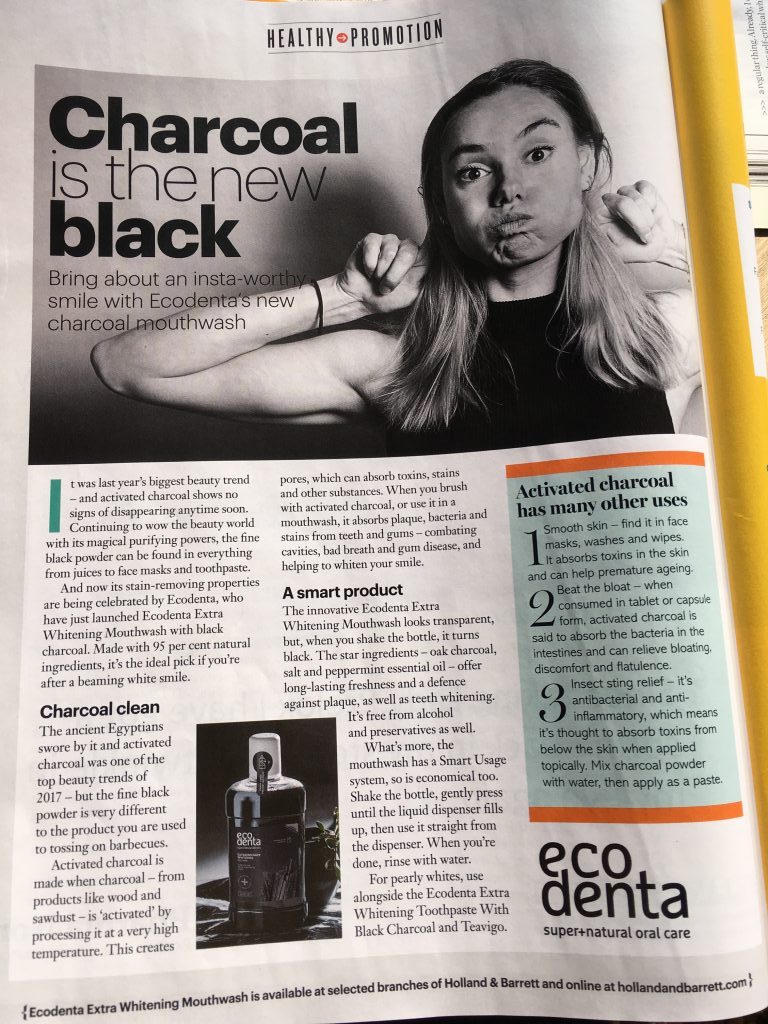Despite being a 30 year old male into pizza and beer, I’ve been reading a magazine targeting female gym goers for a while now (for research purposes. Honest.).
The magazine is called Healthy and it’s sold in Holland and Barrett for £1.99. I can’t imagine the publishers make that much money from magazine sales, but they’re wise business people. They fill the mag with ads.
Some of the ads are good. Some are OK. And some are a lesson in how to make sure readers miss your ads. Here’s an example of the latter:
Above: How to make sure magazine readers miss your ads
I’ll hold my hands up and admit (maybe for the only time ever) that, despite my arrogance, I don’t actually know everything there is to know about advertising. But I do know that the above ad probably cost the advertiser a few hundred pounds. And I also know it won’t be read much at all.
Why?
As you can see, the headline these guys eventually settled on (probably after multiple meetings and conference calls) reads ‘Charcoal is the new black’.
Imagine that line without any body copy. Picture it plastered on a billboard with nothing else.
14 foot high, 48 feet wide.
Charcoal is the new black.
From that billboard, do you have any idea what’s on offer?
If you had to guess, you’d presumably guess charcoal. But it’d be a big guess, you’d be wrong and, even if you were actively in the market for charcoal and happened to walk past the billboard multiple times on a trip to the charcoal store, the line ‘Charcoal is the new black’ still does nothing to stop you in your tracks.
It fails to do the only thing a headline should do. It gives you no reason whatsoever to want to find out more.
What should the headline really say?
From behind this here computer screen, it’s easy for me to point out poor copy. What’s a bit harder – and probably much more useful – is to suggest an alternative.
Like I say, that’s harder. But it’s far from impossible.
Following decades of A/B testing, copywriters know what cultivates interest. Generally speaking, you have three criteria you can work with. In order of effectiveness, they are:
- Appealing to self-interest
- Offering news
- Invoking curiosity
If you want to be really clever, you can attempt to write a line that meets two or more of the above criteria at once, which makes your headline even more inviting. If the line says something unexpected or surprising, that’s better still.
By playing around with the above, you can soon come up with dozens of lines that attract the attention of people who might be interested in buying charcoal mouthwash – which, incidentally, is what the above ad is for.
The line, ‘For white teeth, swill black charcoal’ is lazy – but it’s a solid starting point. The white teeth appeal to self-interest. The idea of swilling with charcoal is unexpected. Swilling with charcoal for white teeth is even more odd. It demands an explanation… so it interests readers into the sales message.
Copywriters have known about and used the above three criteria for decades. They were all developed through A/B tests. They’re proven to work.
What’s most depressing is the writer of the above ad probably knew of them, too. Look again at the ad’s subhead.
‘Bring about an insta-worthy smile with Ecodenta’s new charcoal mouthwash.’
An insta-worthy smile (self-interest). New mouthwash (news). Made from charcoal (surprising).
As a headline, the sub-head would attract readers. The trouble is, very few people will ever read it.
Most readers miss this ad entirely.
Because charcoal is the new black.
Note: It’s possible this ad was subjected to the same kind of treatment that killed this ad’s results.
